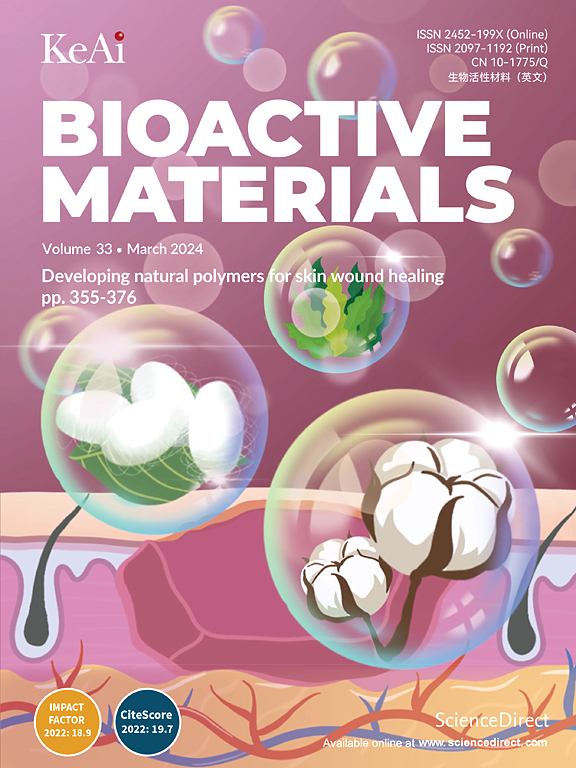Continuous mechanical-gradient hydrogel with on-demand distributed Mn2+/Mg-doped hydroxyapatite@Fe3O4 for functional osteochondral regeneration
IF 18
1区 医学
Q1 ENGINEERING, BIOMEDICAL
引用次数: 0
Abstract
Traditional layered gradient scaffolds are susceptible to delamination owing to abrupt stress alterations, thereby rendering them inefficacious for the integrated repair of osteochondral defects. This study proposed a novel hydrogel possessing continuous magnetic-mechanical and multiple functional metal elements gradients. The establishment of these gradients within the hydrogel was accomplished by first applying a magnetic field to FMHM particles (Fe3O4 deposited with Mg-doped hydroxyapatite (MgHA@Fe3O4) and grafted with γ-(methacryloyloxy) propyl trimethoxysilane) dispersed in poly (ethylene glycol) diacrylate/sodium alginate solution to create a gradient, followed by thermal polymerization to achieve the magnetic and mechanical gradients. Subsequently secondary crosslinking with Mn2+ realized the gradient distribution of Mn2+ which was reverse to the gradient of MgHA@Fe3O4. The on-demand gradient distributions of Mn2+ and MgHA@Fe3O4 enhanced cartilage and osteogenic differentiation of bone marrow-derived mesenchymal stem cells, respectively. The continuous gradient hydrogel attained remarkable repair effects on full-thickness osteochondral defects in rat knee joints. Its capacity to foster the growth of both cartilage and subchondral bone may be associated with the fact that the mechanical gradient modulated the gradient nuclear localization and expression of the mechanosensitive factor Yes-associated protein 1. With stiffness and magnetism gradients, along with the on-demand synergistic impacts of multi-gradient metal elements Mn-Fe/Mg/Ca, this hydrogel presents a prospective option for the regeneration of tissues/interface tissues exhibiting physiological gradients.

连续机械梯度水凝胶,按需分布Mn2+/ mg掺杂hydroxyapatite@Fe3O4用于功能性骨软骨再生
传统的层状梯度支架由于突然的应力变化容易发生分层,从而导致其在骨软骨缺损的整体修复中效果不佳。本研究提出了一种具有连续磁力梯度和多个功能金属元素梯度的新型水凝胶。在水凝胶中建立这些梯度是通过首先对分散在聚乙二醇二丙烯酸酯/海藻酸钠溶液中的FMHM颗粒(Fe3O4与mg掺杂的羟基磷灰石(MgHA@Fe3O4)沉积,并与γ-(甲基丙烯氧基)丙基三甲氧基硅烷接枝)施加磁场以形成梯度,然后进行热聚合以实现磁性和机械梯度来完成的。随后与Mn2+进行二次交联,实现了与MgHA@Fe3O4梯度相反的Mn2+梯度分布。Mn2+和MgHA@Fe3O4的按需梯度分布分别增强了骨髓间充质干细胞的软骨和成骨分化。连续梯度水凝胶对大鼠膝关节全层骨软骨缺损的修复效果显著。其促进软骨和软骨下骨生长的能力可能与机械梯度调节梯度核定位和机械敏感因子yes相关蛋白的表达有关。由于具有刚度和磁性梯度,以及多梯度金属元素Mn-Fe/Mg/Ca的按需协同影响,该水凝胶为具有生理梯度的组织/界面组织的再生提供了一个有前景的选择。
本文章由计算机程序翻译,如有差异,请以英文原文为准。
求助全文
约1分钟内获得全文
求助全文
来源期刊

Bioactive Materials
Biochemistry, Genetics and Molecular Biology-Biotechnology
CiteScore
28.00
自引率
6.30%
发文量
436
审稿时长
20 days
期刊介绍:
Bioactive Materials is a peer-reviewed research publication that focuses on advancements in bioactive materials. The journal accepts research papers, reviews, and rapid communications in the field of next-generation biomaterials that interact with cells, tissues, and organs in various living organisms.
The primary goal of Bioactive Materials is to promote the science and engineering of biomaterials that exhibit adaptiveness to the biological environment. These materials are specifically designed to stimulate or direct appropriate cell and tissue responses or regulate interactions with microorganisms.
The journal covers a wide range of bioactive materials, including those that are engineered or designed in terms of their physical form (e.g. particulate, fiber), topology (e.g. porosity, surface roughness), or dimensions (ranging from macro to nano-scales). Contributions are sought from the following categories of bioactive materials:
Bioactive metals and alloys
Bioactive inorganics: ceramics, glasses, and carbon-based materials
Bioactive polymers and gels
Bioactive materials derived from natural sources
Bioactive composites
These materials find applications in human and veterinary medicine, such as implants, tissue engineering scaffolds, cell/drug/gene carriers, as well as imaging and sensing devices.
 求助内容:
求助内容: 应助结果提醒方式:
应助结果提醒方式:


